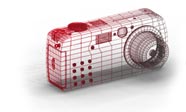 |
|
||
|
|
|
Main / Photography GlossaryA | B | C | D | E | F | G | H | I | J | K | L | M | N | O | P | Q | R | S | T | U | V | W | X | Y | Z Latent Image The invisible image left by the action of light on photographic film or paper. The light changes the photosensitive salts to varying degrees depending on the amount of light striking them. When processed, this latent image will become a visible image either in reversed tones (as in a negative) or in positive tones (as in a color slide). LCD panel ( Liquid Crystal Display.) An electronically generated text, numeric & symbols. Before the popularity of the LCD, LED is the most common method. LCD consume only one fifth (1/5) of the power of the LED and thus have a wider application in photographic line. The only problem is, it'll turn dark at very high temperature (will resume to normal when cool down) and it will fades in extended time. (the Nikon F3 first used LCD display in 1980, I heard none is complaining about this after 17 years, did you ?) Used most commonly on cameras that shows such information as remaining exposures, flash status and aspect ratio selected. LD Low dispersion glass, or UD (ultra low dispersion) or SD (Super Low dispersion), please refer to "ED", basically, refers to optically superior glass - price too! Dispersion sometimes also refer as "colour fringing". Leader (Film Leader). Part of film attached to camera take-up spool. 35 mm film usually has a leader of the shape originally designed for bottom-loading Leica cameras, although most cameras simply need a short taper. LED Light Emitting Diode. Light producing transistors used to display dots, numeric and text in the viewfinder, slowly replacing by LCD display. Lens One or more pieces of optical glass or similar material designed to collect and focus rays of light to form a sharp image on the film, paper, or projection screen. Lens aberration Optical flaws which are present in small amounts in all photographic lenses; made up of chromatic aberration, spherical aberration, curvature of field, distortion, etc.; a perfect lens would show the image of a point as a point and a straight line as a straight line, but in practice, lenses are never perfect: they reproduce a point as a patch and a straight line as a more or less curved band; most of the trouble is caused by aberrations, inherent in the lens construction; it's the job of the lens designer to control most of the aberrations as much as possible by combining a number of single lenses in such a way that the aberrations of one lens tend to be cancelled out by opposing aberrations in the others. Lens Shade A collar or hood at the front of a lens that keeps unwanted light from striking the lens and causing image flare. May be attached or detachable, and should be sized to the particular lens to avoid vignetting. Lens-Shutter Camera A camera with the shutter built into the lens; the viewfinder and picture-taking lens are separate. Lens Speed The largest lens opening (smallest f-number) at which a lens can be set. A fast lens transmits more light and has a larger opening than a slow lens. Determined by the maximum aperture of the lens in relation to its focal length; the "speed" of a lens is relative: a 400 mm lens with a maximum aperture of f/3.5 is considered extremely fast, while a 28mm f/3.5 lens is thought to be relatively slow. Light meter (See Exposure meter) Lighting ratio. The ratio of the brightness of light falling on the subject from the main (key) light and other (fill) lights. A ratio of about 3:1 is normal for colour photography, greater ratios may be used for effect in black-and-white work. Limiting aperture. The actual size of the aperture formed by the iris diaphragm at any setting. Determines, but usually differs from, the eflfective aperture. Long-focus. Lens of relatively long focal length designed to provide a narrower angle of view than the normal or standard lens, which generally has an angle of view, expressed on the diagonal of the film format, of about 45 degrees The long focus lens thus takes in less of the view in front of it but on an enlarged scale. Lux A measurement of the light intensity. One Lux in video means light level of a candle light. |
| © Copyright 2025 ShutterMag.com All Rights Reserved. |
